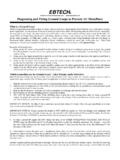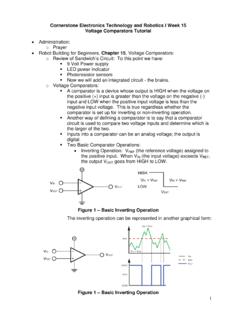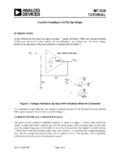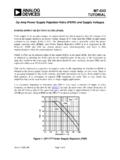Transcription of Active Disturbance Rejection Control - IFAC 2014
1 Active Disturbance Rejection Control Principles, Practices and Prospects A Pre-Conference Tutorial at the 2014 IFAC World Congress Organizers: Zhiqiang Gao, Cleveland State University, ; Bao-Zhu Guo, University of the Witwatersrand, South Africa Overview: This tutorial focuses on the very nature of industrial Control problems: obtaining consistent performance in processes full of uncertainties, the solution of which cannot be easily found in a model-based Control theory. The essence of such problems is Disturbance Rejection , in a general sense, and that the question is how the Disturbance is best mitigated, in view of new principles, methods, algorithms, and rigorous justifications.
2 The solutions, to be truly industrial, must be easily scalable across product lines, or even industry sectors; and they must give what production engineers want: a Control system that makes the difference small between the process variables and their desired values, and does so quickly, economically, and intuitively. The speakers in this tutorial will show, interactively with the audience, that to achieve such a lofty goal, the disturbances must be rejected in an Active manner, meaning that the Control system actively seeks and mitigates the causes of the output deviation, rather than just passively reacts to it. And this is the principle of Active Disturbance Rejection Control (ADRC).
3 Format: The tutorial consists of four sessions: 1) principles, methods and impacts, stretching from the steam engine era to present time; 2) technologies and applications, as ADRC is gaining a foothold in industry; 3) theoretical foundation, rigorous mathematical proofs, and the beginning of a theory of Disturbance Rejection ; and finally 4) prospects for the future development of ADRC. In each of these sessions, the speakers will lead, but not dominate, the proceeding by giving short, concise presentations on the latest developments, followed by a forum of speakers-audience interactions on questions and concerns from participants. Practical problems and examples are used throughout the discussions to help participants connect novel principles to their own experiences.
4 Matlab simulations are shared with the participants to show the simplicity and effectiveness of ADRC. Benchmark problems from various domains of applications are used to demonstrate the novelty of ADRC. Target Audience: practitioners looking for advanced Control solutions that are simple to use and easy to tune; researchers looking for new ideas and the connection between theory and practice; students looking for better understanding of the foundation of controls and the essence of Control engineering practice. I. WHY ADRC? In Control theory, Disturbance Rejection is one of many competing Control design objectives, including command following, robust stability, noise sensitivity, etc.
5 ; in practice, however, it is often THE design objective that is front and center in the mind of design engineers. This tutorial provides a forum for students, researchers and practitioners to share insights on how the Control problems in a particular domain of applications are reduced to the essence, Disturbance Rejection , and what tools are available at our disposal to solve these problems. Through the exposition of various concepts, methods, and solutions of engineering problems, this tutorial provides the audience with a comprehensive understanding of what s unique about the concept of Active Disturbance Rejection Control (ADRC)? What characterizes the ADRC Technology (its pros and cons)?
6 And to what end future lies, in expanding the edge of technology, in continuous regeneration of fresh ideas and in further development of theoretical foundations? Through this discussion we hope that participants will be able to make seamless the integration of the ADRC concepts and the domain knowledge and skills of a particular engineering branch. It is through such integration that users of ADRC will be able to take advantage of it freely in solving the pressing problems of today. Most attendees of the past IFAC World Congress probably have never heard of Active Disturbance Rejection Control (ADRC), nor have they ever seen a tutorial, a conference session, or books devoted to the subject.
7 But perhaps they should, as this proposed tutorial will attempt to show. In the last few years, ADRC has been the subject of short courses at top universities in China, and of invited sessions and tutorials at conferences such as the 2013 American Control Conference, the 2013 Chinese Control Conference and the 2012 World Congress of Intelligent Control and Automation. In China, ADRC as a potential solution has been explored in almost all domains of Control engineering [1]. In the , ADRC algorithm was recently deployed at a Parker Hannifin Extrusion Plant in North America, resulting in over 50% energy saving per line [2,3] across ten production lines; Texas Instrument, an industry giant, has licensed the ADRC technology in anticipation of a massive rollout of a new generation of Control chips within which the ADRC algorithms are embedded [4].
8 There have been numerous reports in industry journals and news papers about this technology and the university spinoff associated with it [4-10]. The idea of ADRC is very intuitive: it single mindedly focuses on Disturbance Rejection as the central task and the Active part comes from mitigating the Disturbance before it runs its course. It is highly likely that whether an ACC attendee is from academia, government labs, or industry, he or she will equally find the subject of ADRC fascinating, if only for the reason that it all started with an obscure idea from the 1820s France when Poncelet wrote in his book that the Control of steam engine could be greatly improved if the Disturbance force is measured and counteracted BEFORE the engine speed deviates.
9 No one paid much attention to it for over a hundred years, before it was rediscovered and revived by a scholar, Shipanov, in the then Soviet Union in 1930s, who in turn got into trouble with the authority on the ideological ground. The story then took a surprising turn when a Chinese scholar, J. Han, rekindled the idea in the 1990s China and formally introduced the concept of ADRC [11-16], which was further articulated and simplified by Z. Gao [17-21]. In recent years, ADRC inspired ground-breaking developments in many areas of engineering practice (see, for example [22-31]) and captured the imaginations of American entrepreneurs and venture capitalists, in an effort to bring it to the market [4-10].
10 The engineering success in turn led to numerous theoretical investigations [32-39] and the discovery of the fact that many previous ideas [40-48] that are scattered over time and isolated by its domain of application can now be unified in a single framework, with their equivalence or similarities laid bare. The following introductory and survey papers can be used as the starting point for interested readers. J. Han, From PID to Active Disturbance Rejection Control , IEEE Transactions on Industrial Electronics, .Vol. 56, Issue 3, pp. 900-906, 2009. Z. Gao, Active Disturbance Rejection Control : A Paradigm Shift in Feedback Control System Design , Proc.







